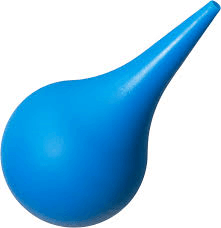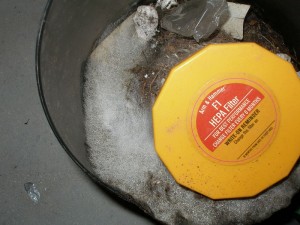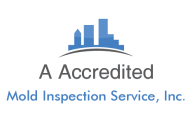Is Mold or Bacteria in Humidifiers
and Baby Toys
Making Your Child Sick?
Information provided by A Accredited Mold Inspection Service.
Many toys are breeding grounds for mold, bacteria, and dust mites that thrives in darkness and moisture. Parents need to be made aware that mold and other microbial growth is common deep inside sippy cups, teething rings, stuffed animals, and ear syringes. The biggest concern may be bacteria in humidifiers.
Such hidden growths inside of baby items may be causing your child’s mold related illness, or your baby’s ear infections.

Ear and nose syringes often contain contaminates that go unnoticed. Be careful not to introduce these contaminates into your babies ears or nostrils.
EAR AND NOSE SYRINGES
A product that has recently garnered news coverage is a light blue ear and nose syringe, or baby nose mucous suction bulb. Kentucky mom Mitzi Johnson made national headlines by cutting a nasal bulb in half and discovering that it was full of mold. She was inadvertently injecting mold into her baby’s sinus each night when she suctioned his nose before bed. She said she always cleaned her son’s nose bulb with hot soapy water after each use but it was not possible to dry the inside. Photos on her Facebook profile page show the inside of the syringe full of disgusting and dangerous mold.
RUBBER DUCKS AND OTHER BATH TOYS
Toy bath duckies and other bath toys float because they are hallow. Because they are hallow and in a watery environment some water may eventually find itsway inside them. Where there is water there is life, the kind of life we are talking about is germs. Mothers know that anything a baby can get its hands on goes straight into the baby’s mouth including contaminated water and gems from inside bath toys. So, care must be taken, be mindful of the presence of stagnant water inside bath toys. Dirty water may reside inside toys, breeding bacteria and mold for years.
PLUSH TOYS
In addition to nasal suction bulbs, many babies are given plush toys to play with… more specifically, to chew on. When a plush toy is washed but not dried completely, it can stay wet inside and the moisture from something as benign as washing can cause it to become a perfect environment for mold. In addition, if dust combines with even a tiny bit of moisture, they become a perfect breeding ground for dust mites. When the baby chews on the toy and squeezes it, microbial growths or dust mite allergens can be forced into the baby’s mouth, and respiratory system.
BACTERIA IN HUMIDIFIERS
One of the most problematic sources of hidden microbial growth is the interior of humidifiers. I have personally conducted several mold inspections where I have found black colored mold in humidifiers or pink bacteria in humidifiers. The black stuff is often Cladosporium mold and the pink film is rod shaped bacillus bacteria. This is likely the most dangerous form of contamination that you could expose your kids or yourself to. This is dangerous because each time the device turns on it forces mold, bacterial, and water droplets out into the air you and your family breaths.
WHY IS HUMIDIFIER CONTAMINATION SO BAD?
In an attempt to help children with respiratory problems, parents are sometimes putting allergens, irritants, and infections agents into their children’s bedroom air. When parents turn contaminated humidifiers on they blow aerosolized droplets of bacteria contaminated or moldy water into the rooms air. Bacteria inside humidifiers and mold in humidifiers is worse than just about anything else we are discussing on this page because large amounts of it are blown out into the air we breathe. And such devices are typically in the rooms of people who are having respiratory problems in the first place.
The tricky thing with vacuum cleaners is that they often have hidden filters. You may clean one and neglect to clean the other vacuum cleaner filter because you never knew it was in there. Also never suck up water into a vacuum cleaner unless it is a wet vac. Doing so with a regular vacuum will result in the dirt and dust inside it becoming wet. Wet dust and dirt will not dry in the vacuum and will result in severe mold growth inside the unit’s dust compartment. Check out this photo of a massive mass of mold fibers growing inside a wet vacuum.

Closer view of the mold. Use of this vacuum will result in many mold spores and mold fibers being dispersed into the homes air if they can manage to bypass the HEPA filter in the vacuum.
WHAT CAN BE DONE
Below is some general advice to lessen the likelihood of exposing your baby to contamination. Of course, you will have to consider your own personal knowledge of the specific situation when deciding how to clean or when to dispose of contaminated items.
CLEAN BABY TOYS
Unfortunately, many toys and suction devices cannot be inspected without destroying them.
If upon closer examination you find clear slime, likely bacteria, red or pink stains also likely bacteria, or black spots, likely mold, then you need to throw the contaminated toys away. To clean baby toys and teething rings use non-toxic sanitizers and mild detergent solutions.
CLEAN OR DISPOSE OF HUMIDIFYERS
In the case of humidifiers follow the manufacturer’s instructions for care and maintenance. Recommendations may be as follows: First make sure it is unplugged because messing with electrical devices and water together is never a good idea. Next disassemble the parts that can be easily disassembled. Soak the parts for 20 minutes in a mixture consisting of one teaspoon of bleach to one gallon of water and wipe clean. Rinse the bleach off and let everything dry for about 24 to 48 hours. Some manufacturers call for the use of a cup of pure distilled white vinegar. Soak for 20 minutes and wipe the disassembled parts with the vinegar, when done rinse the vinegar off and let dry.
A BIT OF CHEMISTRY
If you clean one humidifier with both bleach and vinegar as some manufacturers recommend it could be extremely dangerous. Bleach and vinegar or bleach and any acids should never mix as this forms a toxic chemical.
Never ever mix bleach and vinegar, doing so will result in the following chemical reaction 2HOCl + 2HAc ↔ Cl2 + 2H2O + 2Ac- (Ac: CH3COO). For normal people don’t read chemical equations that equation says if you mix bleach and vinegar (or for that matter bleach and any acid) you will make extremely dangerous chlorine gas.
WHAT ABOUT JUST TOSSING IT OUT?
If you suspect a serious problem in the humidifier open the device and inspect it. If upon closer examination you find clear slime then it is likely bacteria, red or pink stains are also likely bacteria.
Black spots are likely mold. In any of the above cases you will have to decide for yourself what course of action to take next. If contamination appears too excessive to clean, then the best course of action is to throw the contaminated humidifier away.
CLEAN AND SANITIZE SUCTION DEVICES
Prevention is the best cure, don’t let it become a breeding ground. Routinely wash items like ear and nose suction devices out with soap and water to remove debris, and use rubbing alcohol to kill bacteria and mold after each use. If you see black material squirt out, then it is likely bacteria. Clear or white slime squirting out is likely bacteria. And if you see anything come out other than what you intentionally put into it then discard it.
CLEAN OR DISPOSE OF PLUSH TOYS
Clean plush toys with water and a detergent solution per manufacturers recommendations if they are not overly wet or dirty. If they become wet or overly soiled dispose of plush toys. Be very sure to dry them completely until even the inside stuffing is dry or you will be doing more harm than good.
MAINTAIN YOUR VACCUME
Don’t forget to parodically empty vacuum cleaners and clean the HEPA filters inside them. Try not to let the interior of your vac ever get wet. If it gets, then open if fully and let it dry.
Be Observant
And don’t forget this article also applies to all your bathroom items. Check your tooth brushes, tooth and brush holding cup interiors. Also inspect reusable contact lenses and their containers. Other potential growth sites are denture containers, Water Pik type water flossers, make up boxes, and Lufa sponges.





